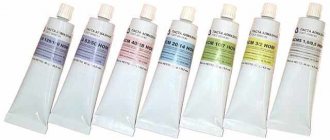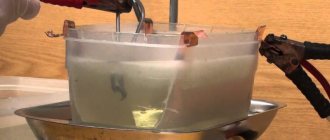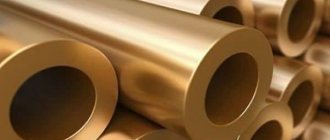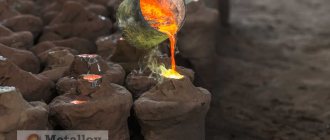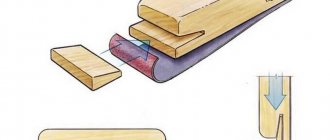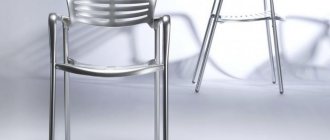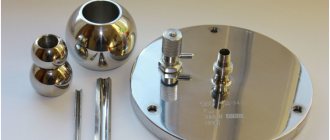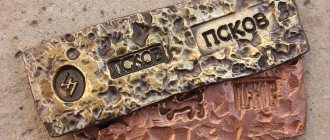The most effective ways
Before you begin cleaning a brass item, you should examine it carefully. It can be made entirely of brass or alloy, or have a lacquered finish. Depending on this, the appropriate cleaning method is selected. It is not recommended to clean rare items, as this removes many years of patina, which gives special beauty and value to the historical item.
Before cleaning brass at home, the item must be thoroughly washed. This is carried out in a solution consisting of 10 liters of ordinary water with a mild detergent dissolved in it (1 tsp). The item is placed in a container with this liquid for 30 minutes, after which it is thoroughly washed with a soft brush or rag. This removes existing dirt, blackness, and green deposits. After each procedure, the item is wiped dry. Next, they move on to the main stage of cleaning the brass object using one of the methods that can be found in the video.
Oxalic acid
This acid is practically never used in its pure form. It is found in many detergents for cleaning bathtubs, tiles, and washbasins. The liquid preparation is applied to the item for a while until the product becomes dark in color. After this, the product is treated with a brush with the dissolved oxide and covered with baking soda. At the end of the procedure, the item is washed under regular running water.
Brass items that have not been cleaned for a long period have a thick layer of oxide. The use of products with a small amount of oxalic acid is ineffective in this case. These products are processed using a different method. Effectively cleaning brass at home when it is heavily oxidized requires preparing a concentrated solution. It consists of 200 g of acid, as well as 10 liters of ordinary water.
As a result of a chemical reaction on an object placed in a liquid, the surface should darken. After this, it is kept under running water and wiped dry. Please note that oxalic acid is a caustic solution, which requires the use of a respirator and protective gloves.
Acetone
Using acetone allows you to thoroughly clean the outside of a brass item from oxides. Under its influence, the outer surface will begin to shine and take on a beautiful appearance. A small cotton swab is moistened with a solvent, after which the product is wiped. It is necessary to clean the surface until the plaque is completely removed. If there is no visible result, pre-soaking is carried out. To do this, use an aqueous solution with vinegar and salt, which is brought to a boil. To increase the processing efficiency, brass items should be boiled for 3-4 hours. Darkening of the surface of the product is normal, which will gradually disappear during the soaking process.
Before cleaning contaminated brass with acetone, you need to know that it is not suitable for treating things that have a lacquered layer. The varnish may completely dissolve, which will require subsequent restoration of the coating.
Toothpaste
You can clean a brass product using your usual toothpaste. The item to be cleaned is washed in a soapy solution to remove and soften massive dirt. After this, a small layer of toothpaste is applied to problem areas. Use a regular napkin to clean the surface. The toothbrush is used exclusively for working in hard-to-reach areas.
Acetic and citric acid
To remove old stains on a brass surface, create a mixture of water, one glass of flour, and table vinegar. It covers the outer surface of the object and waits until the solution dries completely. After this, the mixture is removed from the product and polishing is carried out. You can use hot vinegar yourself. To do this, it is heated on a home stove and applied with a cotton swab to the area to be cleaned. The heaviest areas require multiple treatments.
Removal of oxides and stains is also done with citric acid. Juice is squeezed out of one lemon, salt is added to it until a paste-like mass is obtained. It is applied to the product, gently rubbed, and then washed off with ordinary running water. Don't forget to wipe the shiny brass thing dry.
Sandpaper
Heavily smoked brass products are cleaned with fine-grained soft sandpaper. In this case, the pressing force should be small to avoid damaging the surface of things. Hard-to-reach areas are additionally cleaned using a chemical method.
Soap solution
This solution is used to soak brass items. With mild oxidation, this procedure is quite sufficient to give the item the required appearance. Laundry soap (shavings) dissolves in a bowl of warm water and foams. Brass objects are placed in the liquid and left for several minutes until it cools. After this, the solution is drained and the items are cleaned with a soft bristle brush under running water.
You can add shine to brass items at home using regular table salt with a little lemon juice. In addition, use a mixture of 0.5 liters of buttermilk and 1 tbsp. l. salt. These methods allow you to remove even heavy dirt on the surface of objects and give them a good shine.
Another way is to use fine salt (1 tbsp) with skim cream. The paste is applied to the surface and wiped. For heavy areas, it is necessary to soak the mixture for one hour. At the end of the procedure, the item is washed with water and wiped. Before cleaning brass with salt, make sure it is completely dissolved so as not to damage the item being cleaned.
Specialized means
These drugs are sold in various stores and consist of a concentrated acid solution. These oxide converters are quite effective for items with problem areas. The cleaning procedure is carried out in full accordance with the instructions for the product. At the end of the process, the object must be rinsed to remove any remaining solution. These preparations do not allow the brass surface to oxidize for a very long period, and also maintain its good shine.
Means and methods for cleaning alloys at home
Cleaning brass alloy begins with establishing its authenticity. There are metals that look like brass, but differ in composition. For them, it is necessary to select suitable cleaning products so as not to damage the surface. You can detect brass with a magnet. The alloy will not react to it.
By the way, a brass product does not always need cleaning. Sometimes a natural coating, on the contrary, gives them a noble appearance and increases their value. Once you have determined that the item is made of brass, you can clean it using one of the products.
Professional products
Specialized stores sell brass cleaning products, but when working with them you must follow safety precautions. Wear protective gloves, goggles, and a respirator.
- "Metalin" is a liquid containing 20% hydrochloric acid. Thanks to this, the brass product is effectively cleaned of any contaminants, including poorly soluble salt compounds. In addition, the drug contains inhibitors that create a reliable anti-corrosion layer on the surface, preserving the mechanical properties of the metal.
- “Delu” is an acidic preparation that copes with old stains from oxidation. During use, it emits harmful fumes, so it is necessary to protect the respiratory organs with a respirator.
- “Olex-2 Bronze Cleaner” is a paste-like, strongly acidic product for cleaning the alloy from oxide deposits and grease. After processing, a protective layer is created that prevents oxidation. Working with paste is very easy. Using a cotton swab, apply the product to the surface, wait 5-10 minutes and rinse off.
These cleaners will not only clean the surface, but also polish it.
Vinegar
Using vinegar, only newly formed stains are removed. To do this, it is heated and applied to the alloy. After a few minutes, wipe the surface with a sponge and rinse with clean water.
To clean old stains, mix 0.5 cups of vinegar with 2 liters of water and add a tablespoon of salt. The mixture is heated until it boils, the item to be cleaned is placed inside and boiled for several hours. As the water evaporates, it must be added. As a result of this procedure, dirt and dark spots will disappear. After this, the surface is wiped dry and polished.
Cleaning Tips
Before cleaning brass at home, you need to familiarize yourself with the basic rules of the procedure. Products with lacquer or brass coating cannot be cleaned with aggressive preparations. To do this, wipe with a cloth or a cotton swab dipped in soft soapy water.
For severe oxides and contamination, cleaning agents that do not have abrasive inclusions are used. They can be purchased in specialized stores or prepared at home yourself. The effect of the drug is first tested on an inconspicuous area of the product. Soft brushes are used to remove plaque.
Read also: Bta100 800b connection diagram
Compositions that are based on hydrochloric, citric or acetic acid give a quick effect, but if used incorrectly they can damage the brass surface. Do not forget about safety precautions when using acid preparations.
Methods and means for cleaning brass
In order to give the product its original appearance, you need to know how and with what to clean brass at home. When choosing a purchased cleaning product, be sure to pay attention to the composition and acids contained in it. Each of the acids interacts with metals differently, so the probability of destroying the protective layer along with oxidation is quite high.
What is not recommended to use
To avoid damage and destruction of the protective coating, you need to know about the products that are not recommended for use when cleaning brass. Therefore, first we list the substances that are dangerous to brass:
- Vinegar or acetic acid. When interacting with this acid, products made from “eternal” metal undergo dezincification and acquire a bright red color.
- Sandpaper. Even with the smallest abrasive size, sandpaper can not only scratch the item, but also remove part of the protective coating.
You need to be very careful with store-bought chemicals. Pre-cleaning is, of course, necessary. But before you start the process , you must be familiar with the components of the product. Strong chemicals can not only corrode and destroy the top layer, but also change its structure. Watch the brass and do not leave it in a chemical solution for a long time if you decide to clean it using chemicals.
Removing varnish
Many brass products have a varnish coating. It prevents the surface from oxidizing and maintains the excellent shine of the object. If this layer is damaged, the metal oxidizes and a new varnish is required. Removal of varnish protection can be done under hot water jet. This is the most gentle method of removing nail polish.
In addition, boiling for 3 minutes in a container without aluminum alloy is used. You can purchase special varnish removers from hardware stores. Before cleaning brass with these preparations, carefully read the instructions for use. After the final removal of the varnish layer, the surface is cleaned using one of the selected methods.
Cleaning things made of brass at home is not particularly difficult if you understand the essence of the process and follow the technology correctly. With this approach, beautiful brass products will have a magnificent appearance and will constantly please the eye.
We also recommend reading:
Surely every person at home has things made of brass. Some have dishes, others have jewelry. Some people keep figurines or coins made from this alloy at home. Over time, such products lose their attractive appearance and require attention. There are several ways to properly clean brass at home. To do this, it is necessary to use a special approach so that during the procedure there is no harm to the metal. Particular attention should be paid to antique items that have survived more than one generation.
Autosol – a cleaner for brass)) and more!
The purchase of this metal cleaning product was completely accidental and spontaneous for me: I learned about it in one of the comments from a review on this site. As the owner of a number of brass and not so brass combs, as well as other tchotchkes, brassettes, branzulettes, I decided to order this product and test it with a general cleaning on one of my collectibles. The result and the ease of achieving it were so amazing that I thought I would share my experience with you in this review. AUTOSOL paste arrived in a regular package, but was pretty tattered on the way. The box and tube were crumpled almost to a substandard condition
But everything inside is intact and without damage.
The manufacturer (by the way, has been working for almost a hundred years) cooperates with the European space company EADS, as is proudly stated on the packaging
The tube briefly describes what the paste is for
Much more detailed information
in the attached booklet
Tube weight: 105 grams
It is not sealed under the cap
The smell is quite pungent, petroleum-like. The consistency of the product resembles runny toothpaste or thick sour cream.
Tests:
At the time of writing this review, about two years have passed since I bought my “firstborn” made of brass. Among others, this comb is my most in demand. Of course, I regularly give her “bath procedures” in the form of regular washing with hot water and soap and, in principle, this is enough to remove accumulated impurities, incl. fatty. But let's see what happens after applying Autosol: a few seconds after application and the first light cleaning movements, the product reacts and the cotton fabric turns black from the removed oxides and dirt.
A few more movements and the metal begins to literally shine! It took absolutely no effort to get the comb in perfect condition. I even felt sorry for the beautiful brass patina in the photo below - only half of the product was cleaned.
It took absolutely no effort to get the comb in perfect condition. I even felt sorry for the beautiful brass patina in the photo below - only half of the product was cleaned.
The consumption of paste, it should be noted, is extremely small: for this comb I needed no more than a couple of centimeters from the tube
And the final result:
Fantastic!
It is important that the product is low-abrasive and, in my case, left no scratches at all. But, nevertheless, I will not risk cleaning products made of highly polished metals, although I think that scratches will not appear on them either. From my personal experience, I can confidently recommend this product for use. Wear protective gloves. I forgot about them, my hands washed off easily, but for some time they smelled unpleasant.
NB: Anticipating possible comments about the lack of comparative tests with the famous GOI paste and similar products, I will inform you that this review is exclusively of a spontaneous consumer nature, based on the WOW effect.
* - at the time of writing the review, the paste was not available in the store where the purchase was made, so the link in the product description shows the store closest in price
Effective ways
Before you clean brass from oxides, you need to carefully examine the item. The figurine or decoration can be made entirely of this metal or consist of an alloy. The surface of the product may also have a varnish coating. It is with these points in mind that you need to select a method for cleaning brass at home.
If a rare item becomes dirty, then experts do not recommend removing deposits from its surface, since along with the oxidation layer, the long-term patina, which makes antique items beautiful and provides them with high value, will also be removed.
Before you do the job of cleaning brass at home, you need to give the item a good wash. A fairly simple solution is prepared for this. You need to take 10 liters of water and dissolve any liquid detergent in it in an amount of 1 tsp. Next, an object is placed in this composition, in which it must remain for 30 minutes.
After this, it must be thoroughly washed with a soft brush or cloth. Then dirt, blackness, and green deposits are removed. After completing the procedure, the item must be wiped dry, and then you can proceed to the main stage of cleaning the brass item.
Oxalic acid
This caustic substance is never used in its pure form. It is present as one of the components in many products that are used to clean bathtubs. This acid is also used as an excellent solution for effectively cleaning tiles and sinks. The liquid preparation must be applied to the contaminated item for a while. The acid must remain on the product until it acquires a dark color. After this, the item is processed using a brush, and then covered with baking soda. When the procedure comes to an end, the item is washed.
If a brass figurine or coin has not been cleaned for a long time, then, of course, there will be a thick layer of oxide present on it. The use of a brass cleaner containing a small amount of oxalic acid in this case is not the right solution for effective treatment. It's worth using a different method.
If the item is heavily oxidized, the best option is to use a concentrated solution as a cleaning agent. It is prepared from 200 g of acid and 10 liters of water. During a chemical reaction that occurs on an object that is placed in such a solution, the surface darkens. Then it must be kept under running water and then wiped dry. It should be taken into account that oxalic acid is a rather caustic solution, so when working with it you need to think about protective equipment:
Their use will ensure safe processing of products. Upon completion of the procedure, things will be clean, and there will be no risk to health.
Acetone and salt
You can also use acetone to clean brass products at home. By using it, the owner of the item can quickly clean the outside of it from oxides formed on the surface. Exposure to acetone causes the item to acquire a beautiful shine and become more aesthetically attractive.
Cleaning a brass product with acetone is not a difficult task. You need to take a cotton swab and moisten it with solvent. Next, you should wipe the contaminated product with it. The procedure should be carried out until the plaque is completely removed. If after the completed manipulations no visible result is observed, then in this case preliminary soaking is performed.
For this procedure, you need to prepare an aqueous solution based on vinegar and salt. The product should be brought to a boil. In order to increase the efficiency of processing a brass item, you should boil it for 3-4 hours. When the surface of the product darkens during cleaning, this should be considered normal. It will gradually go away during soaking.
Before you start removing oxidation from an item using acetone, you need to know that you should not use it to clean items that have a varnished layer on the surface. The use of such a substance can lead to such an unpleasant moment as complete dissolution of the varnish. This may require work to restore the coating.
Salt is also an excellent way to restore the former beauty and incredible shine of brass items. A remedy that will help achieve this is prepared from it and a small amount of lemon juice. In addition, a mixture consisting of 0.5 liters of buttermilk and 1 tbsp can be used. l. salt. The use of this method provides an opportunity to eliminate serious contaminants that have arisen on the surface of brass items.
To clean brass from oxidation, you need to take fine salt, which will be required in the amount of 1 tbsp. l. with the addition of low-fat cream. This paste should be applied to problem areas and the mixture should be left for an hour. Then you can start wiping. Upon completion of the procedure, the item must be thoroughly rinsed under water and then wiped dry. Before cleaning, you need to make sure that the salt has completely dissolved and will not cause any harm to the product being treated.
Toothpaste
You can effectively clean brass products by using toothpaste. To remove contaminants, the item to be cleaned is first immersed in a soap solution and washed. It allows you to remove and soften massive deposits. After this, apply a small layer of toothpaste to the problem area. The surface is cleaned using a regular napkin. You should only use a toothbrush if the stained area is located in a hard-to-reach place.
Sandpaper
To clean oxidation from brass, you can use fine-grit sandpaper. In order to remove deposits on the product and prevent its damage, surface treatment must be carried out using careful movements. A chemical method can additionally be used to clean hard-to-reach areas.
Soap solution
This product is mainly used for soaking dirty items. If the brass item is slightly oxidized, then in this case such a procedure will be sufficient to give the item an attractive appearance.
Read also: How to make an air compressor with your own hands video
The process of preparing a cleaning product begins with dissolving laundry soap in the form of shavings in a container with warm water. After this, the composition must be foamed. Next, brass objects are placed in it. They should be kept for several minutes until the product cools down. Then the solution should be drained and a soft bristle brush should be used to clean things. Processing of products with such a tool must be carried out under running water.
Simple folk methods of polishing brass and copper
Brass, as an alloy of copper and zinc, is not a capricious metal: it can be cleaned without resorting to industrial methods. As a polish for brass and copper, you can use available products that work well in cleaning copper alloys. You can use toothpaste, dishwashing detergent, and laundry soap - all these simple devices will help you return your copper items to their attractive appearance. However, if you intend to polish copper and brass to a mirror shine, then traditional methods of cleaning brass and copper can come to your aid.
Table salt and whey
In order to return copper and brass products to their original appearance, you can use the following mixture:
- whey – 200 ml;
- table salt – 1 tsp.
To polish brass, there is no need to immerse the piece in a solution. It is enough to moisten a small piece of rag and carefully treat the surface of an object made of copper or brass.
After polishing, brass and other copper alloys are thoroughly rinsed with cool running water. After this treatment, the product can be used immediately.
Lemon juice and table salt
Lemon juice and table salt in symbiosis can have an excellent cleansing effect on the surfaces of objects made of brass and other copper alloys. In order to put this method into practice, the lemon must be divided into two parts crosswise, and the cut areas must be sprinkled with salt. Holding half a lemon by the base, use the pulp to treat the problem areas of the copper.
After all manipulations, when the mixture of lemon juice and salt has corroded the oxide deposits, the product must be washed, wiped dry, and then polished with a small piece of soft cloth.
Polishing with ketchup
Oddly enough, the savory sauce works great for polishing brass and other copper alloys. To carry out the procedure, you will need a very small amount of ketchup.
Even the cheapest sauce can polish copper items.
Apply a small amount of ketchup to the item that needs polishing, distributing it evenly over the entire surface, leave for a few minutes to allow the destruction of the oxide components to occur.
Excess ketchup is removed with a cotton pad, sponge or cloth, after which the product must be thoroughly rinsed. This procedure will return the brass product to its original shine.
A mixture based on salt, vinegar and flour
To prepare a flour mixture for polishing copper alloys, including brass, you will need:
- vinegar - 1 glass;
- salt – 1 tbsp. l;
- flour – 2–3 tbsp. l.
First of all, salt must be mixed with vinegar in the prescribed proportions. Next, flour is added until a paste of medium viscosity is formed. The mixture can be used in two ways depending on the type of item:
- The dough must be applied to the brass product in a dense layer for 30–40 minutes, after which the surface is well brushed and washed.
- If the inside of a copper utensil needs polishing, the dough is placed directly on the bottom. The mixture must be distributed over the entire area that needs cleaning, after which the container is placed on medium heat. The vinegar and flour are boiled, after which the excess mixture is removed with a brush with stiff bristles.
In the first case, the effectiveness of the “flour” polishing method can be increased by adding a small amount of sawdust to the mixture.
Paste based on chalk and ammonia
To prepare the paste, you need to prepare the following components:
- ammonia solution 25%;
- crushed chalk (lime);
- water.
For 100 ml of water you will need 50 ml of ammonia solution and 20 g of chalk. The paste is applied to the surface of a product made of brass and other copper alloys for 20 minutes, after which it is treated with a high-strength brush and washed with water.
Small items such as coins are completely immersed in a solution of ammonia and chalk.
Using laundry soap
Laundry soap is an effective and economical way to return a brass or copper product to its original appearance of any size, provided there is no oxide.
Specialized means
Any person who needs to clean a brass item can purchase such preparations in various stores. They contain a concentrated acid solution. These agents are called oxide converters. They are quite effective when processing items that have areas of heavy contamination. The procedure should be carried out in full compliance with the instructions for the drug. When the process has come to an end, it is imperative to thoroughly rinse the figurine or decoration in order to wash off any remaining solution.
Such preparations remove dirt well and also provide a number of additional effects:
- do not allow the surface of the brass product to oxidize for a long time;
- keep things beautifully shiny.
When using them, it is extremely important to follow the instructions for use. In this case, fighting deposits on your favorite brass items will become a simple task for the owner.
Cleaning Tips
Before you start cleaning a brass product from contaminants at home, it would be a good idea to learn about the basic rules for carrying out this procedure. If your item has a varnish or brass coating, then you should not remove dirt from its surface using preparations containing aggressive substances. To combat deposits, simply wipe with a cloth or a cotton swab dipped in a regular soap solution. If there is a large layer of contamination on the product, then cleaning compounds are used.
It is necessary to choose products that do not contain abrasive inclusions. If you do not want to purchase store-bought drugs, then an effective composition can be prepared at home. Before you begin cleaning, you should test the homemade product on a small, inconspicuous area of your product. A brush with soft bristles is used as a tool to remove plaque on a brass product.
The following acids provide a quick effect when cleaning objects made of this alloy:
However, if used incorrectly, they can cause damage to the surface of the product. It is also necessary to remember about safety measures when using these substances hazardous to human health.
Removing varnish
Many products made from brass have a varnish coating. Thanks to it, oxidation of the surface of the thing is eliminated, and it also retains its original appearance. If for some reason there is a violation of this layer, then the process of metal oxidation begins. In this case, a new coat of varnish will be required. The varnish protection of an item can disappear if you wash it under hot water. This method of removing varnish is the most gentle on brass products.
In addition, you can use boiling the item. In this case, the item is placed in an aluminum alloy container for 3 minutes and boiled in water for 3 minutes. You can also purchase special compounds in stores that can be used to easily remove varnish from your favorite item. Before using such products to clean brass products, you must carefully read the instructions for use. When the varnish layer is finally removed, you will need to carry out a surface cleaning procedure using one of the listed methods.
Removing contaminants from the surface of brass products is a fairly simple task that can be done at home. In order to get the desired result without causing damage to the item, you should know the rules for cleaning things made from such material, and also use only suitable compositions and home remedies.
By adhering to this approach, after the procedure the owner can return his favorite item to beauty and incredible shine, which will constantly please the eye.
Brass products have a unique and beautiful shine that makes them easy to love. But just as easily it disappears, becoming stained and darkening. Cleaning brass does not take much time and effort, and therefore it is worth knowing how to restore products made from this alloy.
Nuances of updating the protective coating
The above methods for cleaning brass often result in a loss of its original appearance. To update the surface, you will have to remove the varnish layer and apply a new coating. Cleaning brass at home and renewing its coating is carried out according to the following principle:
- work is performed on a flat surface covered with plastic film;
- The old coating is removed with a brush dipped in acetone or nail polish remover.
- metal free from varnish is carefully polished with special pastes;
- Apply a new layer of varnish to the polished surface using a brush or cotton swab.
Varnishing a brass surface must be done very carefully so as not to leave fingerprints on it or damage it with long nails or the tools used.
After all the manipulations, the brass product will become like new and will delight you for a long time.
Copper and its production metal brass (a mixture of copper and zinc) are widely used in various spheres of human life and activity, including in everyday life. Door handles, figurines, teapots and coffee makers, copper strips and other household and interior items are often made of copper or brass, because these metals are not only aesthetic, but also practical. However, over time, the surface of products made of copper and its alloys may tarnish, and a specific coating may appear, which is the result of the interaction of brass and copper with the constituent elements of oxygen. Polishing brass is a simple process that can be done at home using available tools and removes oxides from the surface of copper alloys.
How to care for the alloy
Before choosing a cleaning method, you need to know some recommendations for caring for products made from this type of alloy. A large number of people who have brass products do not know how to clean this material at home, although it is not difficult.
Cleansing should be done using non-aggressive means using soft tissues. Cotton pads can also be used for this. Before you start cleaning, you need to rinse the devices in a soapy solution to wash away dust and other small contaminants.
Heavy stains need to be removed using specialized products that are made with stronger acidic compounds than those that can be found in the kitchen and that are used in traditional methods.
Any product must be tested on a small area of the product, and only then completely clean the device, since otherwise the product may be damaged, and restoration will be difficult or impossible.
Compositions using household acids - citric, hydrochloric, acetic - can quickly and effectively remove stains, but they can also damage a piece of jewelry or figurine, and therefore you should strictly follow the instructions.
Features of the alloy and principles of care
Brass is obtained by combining zinc and copper. The composition may also include other components: tin, nickel, aluminum, etc. The shade and properties of the metal will depend on the type of ligatures.
Adding zinc to the alloy began to be practiced in the 16th century. In Rome, compositions were made from copper and zinc ore, from which jewelry and dishes were made.
Brass is considered an eternal metal because... it practically does not wear out. Having bought a brass item once, you can use it for the rest of your life. Until recently, the ideal proportion of brass was the ratio of copper and zinc 1:2. Now the amount of Zn is reduced to 30% of the total mass. For technical alloys the percentage increases to 50%. The more zinc there is in a product, the cheaper it will cost.
Two-component types, where zinc makes up 20%, are used for the manufacture of automotive parts and thermal equipment. An alloy with 40% zinc is suitable for stamped brass products and fittings. Compositions with a large number of ligatures are used for various purposes. They are used to make pipes, watches, springs, souvenirs, etc.
What does brass look like?
Brass is also suitable for making jewelry. With a certain proportion of components, the alloy can be almost exactly similar to gold. Such jewelry visually resembles precious ones, but costs several times less.
What not to do and use
It is not recommended to use products with hard abrasive particles or thick fabrics for cleaning. Before cleaning, you need to rinse things in a soapy solution to wash away dust, which may also contain abrasives. Do not use brushes with hard bristles or rough fabrics. Such things can leave scratches on brass products, making them look less attractive.
It is not recommended to wash brass utensils, as well as jewelry and figurines in the dishwasher, as they will quickly lose their presentable appearance and begin to darken. Do not leave the caustic composition on the product for a long time. You should constantly check how the brass has been cleaned and whether the product should be washed off.
You cannot use acetic, citric and hydrochloric acid in high concentrations, as they can damage the item. Also, you should not use alkaline-based products, since in this case the darkening will only worsen as the copper will react with oxidation with the alkali.
Do not wash varnished items in hot water, as this will remove the entire coating. However, they should not be polished either. Instead, it is recommended to remove dirt using a soap solution.
Patination of brass
Brass without patination
Medium patina brass
Light patination of brass
Deep patination of brass
Deep green patination of brass
In addition to brass, we often process traditional metals, as there are product designs that combine different materials.
Traditional methods
There are many folk remedies that will help restore the product to its original appearance, and therefore it is worth remembering how to clean brass at home until it shines.
Oxalic acid
Oxalic acid will help get rid of the oldest and most stubborn stains that nothing else can handle. However, when using it, you should remember safety precautions: your hands should be protected with rubber gloves, and you should also use a respirator.
You need to pour a liter of water into a plastic container and dissolve 25 grams of acid in it. You need to moisten a soft sponge in the resulting solution and carefully apply the product to the products. After a third of an hour, you need to rinse everything off with clean water and thoroughly wash the products in a soapy solution.
Acetone
When working with acetone, you should also use rubber gloves. Polishing brass does not take much time: soak a cotton pad in the solution and thoroughly wipe off any discoloration and alloy oxide, and then rinse thoroughly with water and detergent.
Read also: The difference between grinding and polishing
Toothpaste
Polishing brass can be done using regular toothpaste. Before the cleansing procedure, you should wash the items in soapy water, apply a small amount of paste to the brush and begin to clean the product with smooth, light movements. Don't try too hard to avoid leaving scratches. Small stains come off quickly enough.
If there is no result within 10 minutes, then you should use more caustic means to remove contaminants. This polishing paste can remove moderate darkening. At the end of the procedure, you need to rinse the products with clean water and wipe dry.
Acetic and citric acid
Baking soda with citrus and vinegar is great for getting rid of corrosion and oxides. The product should be treated with a slurry of water and soda, and then poured with a small amount of acid. A quenching reaction will occur, during which contaminants will move away from the surface of the product. Then you should rinse everything thoroughly with water and wipe dry.
Sandpaper
Soft sandpaper can also easily correct any imperfections on brass items. It is worth understanding that this method is suitable for rough products: chest handles, fireplace grates or candlesticks, but it is better not to try to use it on jewelry and figurines - scratches will remain.
Soap solution
If the brass has only slightly darkened, you can try to remove the stains using a regular soap solution. Pour warm water into a basin or pan and add soap or detergent. In this case, it is better to use laundry soap, as it contains a large amount of animal fat. The solution should be thoroughly foamed and items that require cleaning should be placed in it. Leave it in this state for a quarter of an hour until the water cools down.
Then you will need to clean it using a soft brush while rinsing it with warm water. It is worth wiping all products dry with a soft cloth. It is also recommended to use a special polish, with which you can achieve the perfect shine of your products.
Acetic acid works well in combination with salt. You need to take a small container and pour water into it. Then, per glass of water - a spoonful of salt, you need to add these ingredients to the water and bring to a boil.
Then, in the resulting broth, you need to boil all brass products for 3 hours. In this case, as it boils, you should add ingredients in the indicated proportions. Don’t forget to wash and wipe the brass products after finishing the boiling process.
Ketchup
Not every sauce is suitable for cleaning brass coating. It is worth choosing one that has a low content of dyes of one kind or another, but a large amount of acidic preservatives. Such a product is able to restore the appearance of products and extend their service life.
You need to apply a small amount of ketchup on a soft sponge, and then rub the product; leave it in this form for at least a third of an hour. Then you should thoroughly rinse and dry the items.
Yogurt
Yogurt with a high content of lactic acids has a beneficial effect on alloys and helps remove oxidation from them. You need to take a pan of yogurt and put the tarnished things in it, leave it in this state for an hour. Then you should rinse the products with clean water and wipe with a soft cloth.
Brass oxidation can be combated by using lime in combination with baking soda. For 50 ml of water you need to take 60 grams of soda and apply the resulting slurry to the darkened areas. Then you should cut the fruit in half and rub the objects with its pulp. You should leave things in this state for 45 minutes, then wash with water and wipe. This method may not work the first time, but it can be repeated to ensure better results.
Chemical and electrochemical polishing of copper and brass
Chemical and electromechanical polishing of copper and brass gives the most effective results, however, these methods are best used in an industrial environment, since the chemical reagents used during cleaning of brass can cause harm to the body.
Chemical polishing
Chemical polishing of copper alloys and other types of products involves placing the item in need of cleaning in a special container filled with a solution of various reagents and acids. The chemical is used to form specific reactions that have a destructive effect on unevenness, roughness and oxide deposits.
The copper product is kept in the solution for the time necessary for the chemical reaction to occur, after which it returns to its original attractive appearance.
Electrochemical polishing
Electropolishing of brass and copper parts is known for the high quality of restoring the surface of a metal product, obtaining a mirror surface and impeccable smoothness. Sulfuric or phosphoric acids most often act as a conductor of electricity.
The electrolyte is placed in a special bath with an additional layer of lead or polyethylene and heated to a temperature of 60–90 degrees Celsius. Lead cathodes are attached to parts made of copper alloys. The current density corresponds to 10–50 A/dm². The part should be treated in the electrolyte solution for approximately 5 minutes.
Specialized means
To clean brass products, you can also use specialized products, of which there are a large variety on the modern market. They are made on an acid base, which is better suited for removing rust and deposits from alloy products.
The most popular and effective at the moment are “Delu” and “Metalin”. They help restore the original shine of the product in case of heavy contamination, but when processing with these products it is necessary to take all precautions: use a respirator and rubber gloves.
You should carefully read the instructions for use, which are indicated on the label of the product. Products must be cleaned using a soft cloth, completing the cleaning process by rinsing with plenty of running water and then wiping dry with a cloth.
These same products are suitable if the question arises of how to clean the samovar. You can try your luck with folk remedies, but cleaning such a large item will take a long time. A brass samovar cannot be cleaned with abrasives, but after treatment with specialized products it should be polished with a dry cloth or using special polishes.
Tips and tricks
To avoid constant questions about what and how to clean brass, it is worth thinking about preventive measures. There are many cleaning products available, but you won't need them unless the brass is tarnishing or rusting. For a permanent shine, these items only require regular mechanical dry cleaning using soft bristle brushes or soft cloths.
You should not allow dust to accumulate in hard-to-reach places, and you should also store products in a room with low humidity, as it causes the copper alloy to darken. Brass also does not tolerate ultraviolet radiation, and therefore it is recommended to store all products in cabinets and drawers. Most often, because of this, the frame of the icon, which is usually displayed in the red corner of the house, suffers.
If you use specialized polishing products, all products will retain their original shine for a long time. At the same time, it is worth taking care that jewelry or utensils made of brass, copper and bronze are stored separately. It is advisable to buy special cases lined with velvet on the inside for these purposes. This way they will not darken due to the lack of ultraviolet radiation, they will not be scratched because the velvet is quite soft, and the corrosion process will not start due to the lack of moisture, which will extend their service life.
Removing varnish
If the above methods do not produce the desired result, then it is worth replacing the varnish on the product, and this will require removing the previous layer of varnish. You can perform a similar operation at home, following a certain algorithm.
You first need to protect the work surface and yourself from the varnish. To do this, just put on special clothes and lay plastic film on the surface. Use nail polish remover to remove the previous layer. This procedure must be carried out away from fire, as the liquid is flammable.
Then you should polish the product with polish and apply a new layer of varnish. In this case, the layer should be thin and applied evenly. A brush or cotton pad will help with this. It is more convenient to use an aerosol. Then you just have to wait until it dries and use a soft cloth to polish the product until it shines.
Varnish removal can also be done under hot water pressure. The method is more gentle than the previous one, since no chemical compounds are used. Boiling for 3 minutes in a container without aluminum works in a similar way. If you follow all the instructions correctly, you can remove varnish and dirt with your own hands without any heavy effort.
